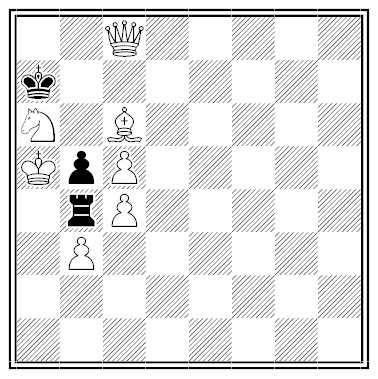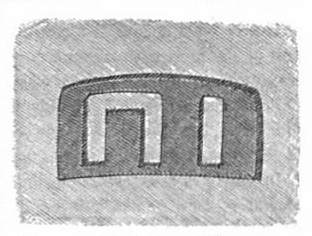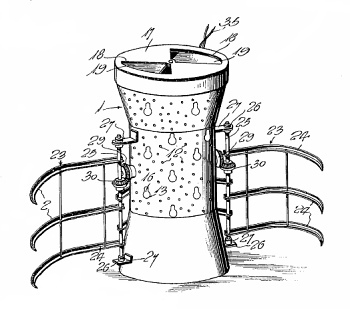
An anonymous puzzle from the British Chess Magazine, 1993. White to mate in half a move.

An anonymous puzzle from the British Chess Magazine, 1993. White to mate in half a move.
“Twelve Ways to Commit Suicide,” from the American Medical Journal, reprinted in the Manhattan and de la Salle Monthly, 1875:
Adam and Noah exist here now. Adam lives to be 930, Noah 950. We can imagine a possible world in which they swap ages and yet retain their essential identities. But we can also imagine a further world in which they swap ages and names; another in which they swap ages, names, and hat sizes; and finally a world in which Adam and Noah have swapped all their qualitative properties.
Now isn’t Adam in our world identical with Noah in the other world? For how are they distinct? If a thing can retain its essential identity when a single property is changed, then, writes Willard Van Orman Quine, “You can change anything to anything by easy stages through some connecting series of possible worlds.”
See Spare Parts.

The above line of figures does not appear very interesting at first sight, but if one asks some charming member of the fair sex to turn it upside down and hold it to a mirror to read it, a hidden meaning becomes apparent.
— Strand, December 1908
Print our alphabet on a series of dials, like a combination lock, and you can arrange them to spell I GOT UP TO FAINT:

In a sense this sentence is latent in our alphabet; it’s an artifact of the customary order in which we list the letters.
Further hidden messages, for what they’re worth:
In Carl Sagan’s 1985 novel Contact, an astronomer discovers that if pi is expressed in base 11, a field of 1s and 0s appears 1020 digits from the decimal point. If carriage returns are inserted at certain intervals, this field produces the image of a circle — apparently the signature of a designer who devised our mathematics itself. But even in the book, no one knows what this means.

From the American Journal of Science: In November 1829, a 30-cubic-foot block of marble was raised from a quarry northwest of Philadelphia and taken to a Norristown sawmill to be cut into slabs.
“One was taken off about three feet wide and about six feet long, and in the body of the marble, exposed by the cutting, was immediately discovered an indentation, about one and a half inches long and about five eighths of an inch wide, in which were the two raised characters” (left).
“Fortunately, several of the most respectable gentlemen residing in Norristown were called upon to witness this remarkable phenomenon, without whose testimony it might have been difficult, if not impossible, to have satisfied the public, that an imposition had not been practised by cutting the indentation and carving the letters after the slab was cut off.”
No explanation is offered. The block had been raised from a depth of 60-70 feet in the quarry.
There was a young fellow named Tait,
Who dined with his girl at 8:08;
But I’d hate to relate
What that fellow named Tait
And his tête-à-tête ate at 8:08!
— Anonymous, in A Book of American Humorous Verse, 1917
In 1744, 11-year-old Matthew Daking of Yorkshire emerged from a fever with such a ravenous appetite that “if he was not fed as he called out for it, he would gnaw the very flesh off his own bones.” When Matthew was awake, he was devouring food — though “it can hardly be said eating, because nothing passes his stomach, all is thrown up again.”
Here’s a sample of his diet, as reported in the Philosophical Transactions — an incredible 384 pounds of food in six days:


This continued for more than a year, with Matthew losing strength as his appetite grew. Eventually he lost the use of his legs. “He is sometimes so hungry, that he says he could eat them all,” reported Dr. J. Cookson. “He often wishes he were in the king’s kitchen.” He died a few months later, “quite emaciated.”
lychnobite
n. one who works at night and sleeps during the day

Stanley Valinski patented this “man-catching tank” in 1921, “for use in banks for catching and holding burglars or the like.”
The steerable armored enclosure sits in the lobby with a watchman inside. If the bank is robbed, the watchman pushes a button to summon the police, then drives the tank to block the door, where he can cover the bandits with a gun or grab them using the angle frames.
It’s remarkably well thought out: There’s even a separate hatch by which bank officials can enter the tank if the watchman is shot. Probably best not to mention that in the interview.